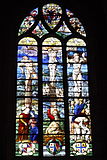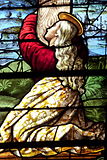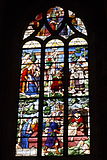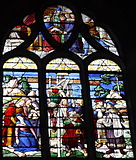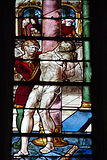St-Pierre (Limours)
The Catholic parish church of Saint-Pierre in Limours , a parish in the Essonne department in the French region of Île-de-France , was built in the first half of the 16th century in the Flamboyant Gothic style. In the church there are stained glass windows from the Renaissance , which were listed as a historical monument in 1888. In 2006, the church dedicated to the Apostle Peter was added to the list of architectural monuments in France as Monument historique .
history
Limours Church is first mentioned in 1091. At that time it became the property of a priory that was subordinate to the Benedictine abbey of Bourgueil . The church was both a parish and a monastery church and, in addition to the patronage of the Apostle Peter, also had that of the Evangelist Mark , of whom the church had relics . Of this church building, which was destroyed during the Hundred Years War , only the crypt under the present church remains .
In the 1530s, the royal tax farmer Jean Poncher, who had acquired the rule of Limours in 1516 , and his wife Catherine Hurault had a new church built. The coats of arms of the two families are depicted on the keystones of the vault and in the leaded glass windows. In the 17th century, Gaston d'Orléans , the younger brother of the French King Louis XIII. and then the lord of Limours, the construction of the bell tower, which was not completed until 1902 under the architect Marcel Lambert, but received no bells.
architecture
Exterior construction
On the north side of the west facade rises the bell tower, which is crowned by a dome and a surrounding balustrade. Like the outer walls of the church, it is reinforced with buttresses . A small round window and a portal decorated in the Flamboyant Gothic style with a keel arch and crab-studded pinnacles are cut into the west facade . On the crossing sits a slate roof turret .
inner space
The single-nave church is built over the plan of a Latin cross . The nave is divided into four bays and covered with a groin vault. In the southern arm of the transept, on the site of today's sacristy , there was formerly the palace chapel consecrated to St. Anne . It had direct access to the now no longer preserved castle and, like the choir, is covered with a ribbed vault.
Leaded glass window
Four large stained glass windows with scenes from the Passion of Jesus have been preserved in the choir . The windows were probably made in a Paris glass painting workshop around 1530. Engravings by Albrecht Dürer served as templates for the scenes . The coats of arms of the Hurault and Poncher families are integrated into the lower panes.
- Window 0
The crucifixion of Christ is depicted on the three lancets of the central choir window, and the crosses of the two thieves stand on the side . Mary and the apostle John mourn under the cross on the left, soldiers are depicted under the cross on the right. Mary Magdalene holds the foot of the cross . The tracery commemorates the betrayal of Judas .
- Window 1
The windows of the tracery show Jesus and the sleeping disciples on the Mount of Olives. Christ's crowning of thorns is shown below. On the lower image level, Jesus carries the cross and meets St. Veronica , who hands him the handkerchief.
- Window 2
In the tracery, Jesus is presented to the high priest Caiaphas . The lancets below represent the Descent from the Cross and the Entombment.
- Window 3
On the window in the tympanum the Lord's Supper is depicted , in the upper fields the flagellation and below Jesus before Pilate .
- Window 4 and 5
Only in the tracery are panes from the 16th century preserved in these two windows. On the window 4 the evangelist Mark is presumably shown with his lion, surrounded by angels. God the Father , also surrounded by angels, is depicted on window 5 .
Furnishing
- The colored carved figures of St. Sebastian and Christ on the cross are dated to the 16th century. The terracotta sculptures of the Evangelist Mark and the Pietà date from the 19th century.
organ
The organ was built in 1866 by the brothers Louis and Robert Damiens from Gaillon . The organ stands on a wooden stage above the portal. The organ case is made of oak. It is divided into three sections. The register Montre 8 ′ is in the prospectus. The gaming table is located on the back of the case. Originally the instrument had a transposing device, but it is not working; the manual is still designed accordingly, but can only be played with a range of C – f 3 .
The instrument has eight manual registers (Flûte 8 ′, Bourdon 8 ′, Gamba 8 ′, Voix céleste 8 ′, Prestant 4 ′, Doublette 2 ′, Hautbois 8 ′, Trompette 8 ′). The pedal is permanently attached, but has no registers of its own. It originally had a range of 13 keys and was later expanded to a range of C – f 1 . In 1989 and 1990 the instrumental part of the organ was added to the list of Monuments historiques .
literature
- Louis Grodecki, Françoise Perrot, Jean Taralon (eds.): Les vitraux de Paris, de la région parisienne, de la Picardie et du Nord-Pas-de-Calais . (= Corpus Vitrearum Medii Aevi ). Récensement des vitraux anciens de la France. Volume 1, Éditions du Center National de la Recherche Scientifique, Paris 1978, ISBN 2-222-02263-0 , pp. 81-82.
- Jean-Marie Pérouse de Montclos (ed.): Le Guide du Patrimoine. Île-de-France . Hachette, Paris 2nd edition 1994, ISBN 2-01-016811-9 , p. 369.
- Georges Poisson (ed.): Dictionnaire des Monuments d'Île-de-France . Éditions Hervas, Paris 2001, ISBN 2-84334-002-0 , p. 443.
- Le Patrimoine des Communes de l'Essonne. Flohic Éditions, Volume 2, Paris 2001, ISBN 2-84234-126-0 , pp. 542-543.
Web links
- Église Saint-Pierre in the Base Mérimée of the French Ministry of Culture (French)
- Église Saint-Pierre Mairie de Limours (accessed January 29, 2015, in French)
- Église Saint-Pierre Diocèse d'Evry (accessed January 29, 2015, French)
- Église Saint-Pierre topic-topos (accessed January 29, 2015, French)
Individual evidence
- ↑ Église Saint-Pierre in the Base Mérimée of the French Ministry of Culture (French)
- ↑ Saint Sebastian in Base Palissy of the French Ministry of Culture (French)
- ↑ PM91002321 Evangelist Markus in Base Palissy of the French Ministry of Culture (French)
- ^ Pietà in the Base Palissy of the French Ministry of Culture (French)
- ↑ Information on the organ
- ^ Organ in the Base Palissy of the French Ministry of Culture (French)
Coordinates: 48 ° 38 '44.6 " N , 2 ° 4' 39.9" E



